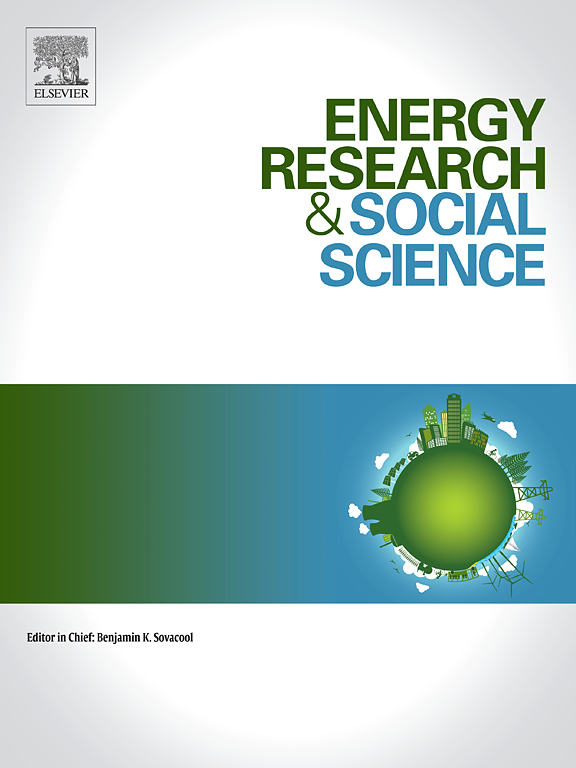Spatial distributive justice has many faces: The case of siting renewable energy infrastructures
IF 6.9
2区 经济学
Q1 ENVIRONMENTAL STUDIES
引用次数: 0
Abstract
Infrastructures for using renewable energy sources (RES) produce local benefits and burdens for communities in their vicinity. The spatial distribution of these local benefits and burdens is typically heterogeneous, which frequently raises concerns of spatial distributive justice. In this paper, we first develop an analytical framework to synthesize the literature in this field. Our framework highlights that approaches to spatial distributive justice have to answer three fundamental questions: Who are the recipients of spatial distributive justice? Which local benefits and burdens are to be distributed in space? Which principle of spatial distributive justice is applied? We observe that existing studies use very different specifications of spatial distributive justice, and usually only one specification at a time. We complement our analysis by an exemplary numerical illustration using data for current RES deployment in Germany. Varying our specifications regarding recipients (states vs. counties vs. individuals), RES infrastructure (onshore wind power vs. utility-scale solar photovoltaics) and the principle of distributive justice (equality principle vs. ability principle vs. benefit principle) leads to a relatively wide range of Gini coefficients (an established measure of spatial disparity) from 0.37 to 0.84. This illustrates that different specifications of spatial distributive justice may lead to deviating, even contradictory, assessments of the existing spatial distribution of RES infrastructures. Our analysis suggests that assessments should apply a transparent and comprehensive approach to spatial distributive justice, including all relevant RES infrastructures, the full set of local benefits and burdens, and variations in the assumed recipients and principles of spatial distributive justice.
空间分配公正有很多方面:可再生能源基础设施选址案例
使用可再生能源(RES)的基础设施会给其附近的社区带来地方效益和负担。这些地方收益和负担的空间分布通常是不均匀的,这经常会引起人们对空间分配公正性的关注。在本文中,我们首先建立了一个分析框架,以综合该领域的文献。我们的框架强调,空间分配公平的方法必须回答三个基本问题:谁是空间分配正义的接受者?哪些当地利益和负担应在空间中分配?适用哪种空间分配公正原则?我们注意到,现有的研究对空间分配公正采用了非常不同的规范,而且通常一次只采用一种规范。我们使用德国当前可再生能源部署的数据进行了示例性数字说明,以补充我们的分析。我们对接受者(州对县对个人)、可再生能源基础设施(陆上风力发电对公用事业级太阳能光伏发电)和分配公正原则(平等原则对能力原则对利益原则)的不同描述,导致基尼系数(衡量空间差异的既定指标)在 0.37 到 0.84 之间的相对较大范围。这说明,不同的空间分配公正规范可能导致对可再生能源基础设施现有空间分布的评估出现偏差,甚至相互矛盾。我们的分析表明,评估应采用透明、全面的方法来实现空间分配公平,包括所有相关的可再生能源基础设施、全部的地方收益和负担,以及空间分配公平的假定接受者和原则的变化。
本文章由计算机程序翻译,如有差异,请以英文原文为准。
求助全文
约1分钟内获得全文
求助全文
来源期刊

Energy Research & Social Science
ENVIRONMENTAL STUDIES-
CiteScore
14.00
自引率
16.40%
发文量
441
审稿时长
55 days
期刊介绍:
Energy Research & Social Science (ERSS) is a peer-reviewed international journal that publishes original research and review articles examining the relationship between energy systems and society. ERSS covers a range of topics revolving around the intersection of energy technologies, fuels, and resources on one side and social processes and influences - including communities of energy users, people affected by energy production, social institutions, customs, traditions, behaviors, and policies - on the other. Put another way, ERSS investigates the social system surrounding energy technology and hardware. ERSS is relevant for energy practitioners, researchers interested in the social aspects of energy production or use, and policymakers.
Energy Research & Social Science (ERSS) provides an interdisciplinary forum to discuss how social and technical issues related to energy production and consumption interact. Energy production, distribution, and consumption all have both technical and human components, and the latter involves the human causes and consequences of energy-related activities and processes as well as social structures that shape how people interact with energy systems. Energy analysis, therefore, needs to look beyond the dimensions of technology and economics to include these social and human elements.
 求助内容:
求助内容: 应助结果提醒方式:
应助结果提醒方式:


